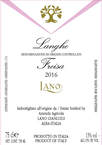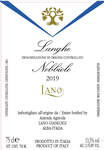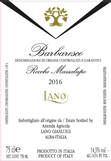Azienda Agricola Lano Gianluigi
First and foremost, Gianluigi is a steward of his land in the rolling hills of Piedmont south of Treiso. In 1993, he took over from his father and began bottling the wines under his own label. In the process he radically changed the course of the estate, and has become a quiet trailblazer among like minded growers. He farms regeneratively in order to build the top soil of his vineyards. This means he never ploughs his vineyards...ever! He lets wild plants grow between the rows to bring nutrients back into the vines. He experimented briefly with planting specific plants but found the wild biodiversity brought better results. As a result he has over a foot of top soil in his vineyards, which is quite astounding when you see his neighbors vines planted directly on the calcareous clay limestone. For the vines his healthy soil creates a more moderate microclimate, reduces water stress, and increases microorganism life necessary for the vine's nutrient absorption.
Gianluigi is fastidious in all aspects of viticulture. He is certified organic, of course, but his minimalist approach goes far beyond the avoidance of synthetic fertilizers, herbicides, or pesticides. In fact, he never sprays anything (including copper or sulfur) after early July. The only time he does spray is in the wettest parts of the spring, and even then using at most half of what is allowed. During the vintage, he never prunes the new growth. Instead the young tendrils are tucked between the training wires. This directs the vine to grow away from the fruit zone and increases concentration. Bird and bat houses ring his vineyards to eat the insects that prey on his crop.
Drinking the wines of Gianluigi is to be transported back in time. His work in the cellar is done with the utmost respect to tradition. All fermentations are and have been with native yeasts since 2000. No new oak is employed in the cellar and the aging for the top wine is in large vats. The wines are sulfured sparingly, and they are never fined or filtered. The results are deeply textural wines that combine the dark fruit intensity of Piedmont with the sublime tertiary qualities that traditional winemaking brings.
Gianluigi is fastidious in all aspects of viticulture. He is certified organic, of course, but his minimalist approach goes far beyond the avoidance of synthetic fertilizers, herbicides, or pesticides. In fact, he never sprays anything (including copper or sulfur) after early July. The only time he does spray is in the wettest parts of the spring, and even then using at most half of what is allowed. During the vintage, he never prunes the new growth. Instead the young tendrils are tucked between the training wires. This directs the vine to grow away from the fruit zone and increases concentration. Bird and bat houses ring his vineyards to eat the insects that prey on his crop.
Drinking the wines of Gianluigi is to be transported back in time. His work in the cellar is done with the utmost respect to tradition. All fermentations are and have been with native yeasts since 2000. No new oak is employed in the cellar and the aging for the top wine is in large vats. The wines are sulfured sparingly, and they are never fined or filtered. The results are deeply textural wines that combine the dark fruit intensity of Piedmont with the sublime tertiary qualities that traditional winemaking brings.

Langhe Rosso 'Lanot'
A blend of 70% Barbera and 30% Freisa from vineyards planted at 250m on calcareous clay. Fermentation with native yeasts and maximum 15 days on the skins with manual cap punching and occasional rack and return. Aging in cement and stainless steel. Unfined/unfiltered.
A blend of 70% Barbera and 30% Freisa from vineyards planted at 250m on calcareous clay. Fermentation with native yeasts and maximum 15 days on the skins with manual cap punching and occasional rack and return. Aging in cement and stainless steel. Unfined/unfiltered.

Barbera d'Alba
Manual harvest from vineyards planted at 250m on calcareous clay. Fermentation with native yeasts and maximum 15 days on the skins with manual cap punching and occasional rack and return. Aging in cement and stainless steel. Unfined/unfiltered.
Manual harvest from vineyards planted at 250m on calcareous clay. Fermentation with native yeasts and maximum 15 days on the skins with manual cap punching and occasional rack and return. Aging in cement and stainless steel. Unfined/unfiltered.

Langhe Freisa
Manual harvest from vineyards planted at 250m on calcareous clay. Fermentation with native yeasts and 3-4 days on the skins with manual cap punching and occasional rack and return. Aging in 500l old tonnaux for 12 months. Unfined/unfiltered.
Manual harvest from vineyards planted at 250m on calcareous clay. Fermentation with native yeasts and 3-4 days on the skins with manual cap punching and occasional rack and return. Aging in 500l old tonnaux for 12 months. Unfined/unfiltered.

Langhe Nebbiolo
Manual harvest from vineyards planted at 250m on calcareous clay. Fermentation with native yeasts and maximum 15 days on the skins with manual cap punching and occasional rack and return. Aging in 500l old tonnaux for 12 months. Unfined/unfiltered.
Manual harvest from vineyards planted at 250m on calcareous clay. Fermentation with native yeasts and maximum 15 days on the skins with manual cap punching and occasional rack and return. Aging in 500l old tonnaux for 12 months. Unfined/unfiltered.

Barbaresco 'Rocche Massalupo'
A single vineyard Barbaresco in Treiso located a quick walk from the winery. The oldest vines on the plot are over 50 years old and are planted at 250m on calcareous clay. Fermentation with native yeasts and maximum 15 days on the skins with manual cap punching and occasional rack and return. Aging for 2 years in old 25hl wood casks. Unfined/unfiltered.
A single vineyard Barbaresco in Treiso located a quick walk from the winery. The oldest vines on the plot are over 50 years old and are planted at 250m on calcareous clay. Fermentation with native yeasts and maximum 15 days on the skins with manual cap punching and occasional rack and return. Aging for 2 years in old 25hl wood casks. Unfined/unfiltered.